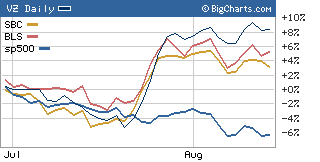
NEW YORK (CNN/Money) -
The worst may finally be over for many telecom stocks.
The market has struggled since the end of June but many telecoms have shined. While the Nasdaq has sunk 13 percent so far in the third quarter, the average gain for the three major Baby Bells (Verizon, SBC Communications and BellSouth) is 6 percent.
Other telecoms, including Sprint and rural telecoms Alltel, CenturyTel and Citizens Communications, are also up.
The momentum may continue. For one thing, investors lately are getting more interested in companies that pay healthy dividends. (For more about tech and telecom dividends, see Tech security blanket.)
CenturyTel pays a relatively small dividend, yielding just 0.7 percent. But the other six companies all have yields above the S&P 500's average, topping out at Citizens Communications' 8.1 percent yield.
Long distance competition fading
More important, telecom fundamentals are finally improving. Federal regulators ruled this year that the Bells, a group that also includes Qwest Communications (Q: Research, Estimates), would no longer have to lease access to their networks to competitors at discounted rates.
As a result, AT&T (T: Research, Estimates) decided last month that it will stop trying to win new consumer local and long distance landline business and MCI (MCIP: Research, Estimates), fresh out of bankruptcy, is focusing more on corporations. That removes significant competitive pressure from the Bells and rural companies.
| �Data as of 8/16/04 | | �Source:��Thomson/Baseline |
|
"The regulatory issue is the big thing in the mix," said Kevin Calabrese, an analyst with Argus Research. "I think these companies are back on track."
Of course, telecom is still a ridiculously competitive business.
One fear that may be overblown, however, is the threat from cable companies and upstarts offering phone service over the Web, a technology known as voice over Internet protocol (VoIP).
VoIP, while widely hyped, is still a small business. And it's not as if the major telecoms have ignored the the technology -- as demand picks up, they are sure to capture some of the growth.
Strength in wireless is a plus
It turns out that the biggest competitive threat to traditional telecoms is probably something that they are already pretty familiar with: the cell phone.
 |
|
| What sell-off? Shares of the three major Bells have more than held their own this summer. |
"Even though the media is extremely focused on VoIP, I think we'll look back five to 10 years now and say that the bigger threat to landlines was wireless replacement," said Tavis McCourt, an analyst with Morgan Keegan.
The three major Bells, Sprint and Alltel already have sizable wireless divisions. So even though they have been, and will probably continue to, lose consumers in their traditional landline business, the hope is that they can gain back some in wireless.
"There is a growing sense that these companies have strong wireless businesses and the market hadn't been appropriately valuing them," said Allan Tumolillo, chief operating officer of Probe Financial Associates, an independent research firm focusing on telecom.
AT&T and Qwest on the other hand simply resell wireless business from other carriers while MCI has no major wireless presence. That will most likely hurt them in the long run.
| Recently in Tech Biz
|

|
|
|
|
In addition, the more locally oriented phone companies have been aggressively rolling out other products such as high-speed Internet access. That should help the telecoms in their battle with cable giants as well.
The fears that the locals' customer bases would whittle away to almost nothing seem to be unfounded. Unlike the two top long distance companies, they at least are able to offer comprehensive telecom service packages.
"The Bells and rural companies are much more insulated from competitive threats because they tend to be in the bundle business," said Pete Wilson, chief executive officer of Telwares, a telecom research and consulting firm. "I think the stock prices now reflect longer-term optimism."
However, there are still some worries that these stocks may have moved too far too fast.
The hope is that the telecoms will finally be able to start showing more solid growth. But for now, analysts are still predicting pretty anemic earnings outlooks.
Sprint is the notable exception, with an estimated long-term earnings growth rate of 16 percent. But the three top-tier Bells and three rural companies have long-term growth projections of about 5 percent to 6 percent.
"This rally will probably be short-lived. I still think there's a lot of risk in this sector," said Patrick Comack, an analyst with Variant Research. "Growth is still slow so investors should be wary of jumping in to the stocks."
But Calabrese argues that most of these telecoms have done a solid job of cutting costs. So as long as they can continue to expand in newer product areas, the incremental sales gains will flow down quickly to the bottom line -- current estimates could wind up being too low.
Analysts quoted in this story do not own shares of the companies mentioned and their firms have no investment banking ties with any of the companies.
Sign up to receive the Tech Investor column by e-mail.
Plus, see more tech commentary and get the latest tech news.

|

